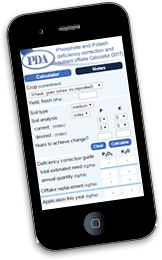PDA News
The PDA publishes both technical News items and shorter Blog items. PDA News provides the latest up to date information on macronutrients and their use, while blog items are shorter and timelier.
If you are in the UK or Ireland and are interested in receiving PDA News items through the post or by email free of charge, then sign up on the contact page. Recipients can receive CPD points for BASIS and NRoSO.
Soil sampling under different cultivation practices
The premise for ensuring crops and grass have access to sufficient quantities of phosphorus and potassium to meet their uptake requirements over the course of a season is to assess the soil reserves. This is carried out in practice by taking a soil sample, either to 15cm depth in arable soils, or 7.5cm depth in […]
December 2020
Nutrient removal from stewardship options
Stewardship schemes can form a vital part of a farming business, for both social and financial reasons. That can be the case whether it’s the existing schemes, or future ones yet to be finalised. Many of the highest paid options for arable land are the part or whole field parcel, rotational options, such as AB1 […]
November 2020
Potassium and pest pressure
Barley yellow dwarf virus is the most economically important virus in UK cereals, with severe infections causing losses of up to 60% in winter wheat and 50% in winter barley. Although this is rare, significant economic damage can occur from small populations of aphids carrying the virus. The effects of BYDV can also be exacerbated […]
October 2020
Potash for OSR
Oilseed rape is going through a tough period at the moment, rapidly falling out of favour on-farm due to difficulties with establishment following the loss of neonicotinoid seed treatments in 2014. On top of this it has also faced increasing challenges with Clubroot, Turnip Yellows Virus, erucic acid levels and weed control. However, despite these […]
August 2020
Record rainfall impacts soil nutrient levels
It will probably come as no surprise that the high level of rainfall seen over winter throughout most parts of the UK has resulted in lower soil nutrient levels when analysed.
July 2020
Potash for grass
Many farmers are not getting the best from their grassland because of a lack of potash. Any green material removed from fields also removes large quantities of potash which will need replacing to ensure grass productivity is maintained.
June 2020
Crop stress responses
It has been stressed many times about the importance of potassium in crops suffering from drought stress, and each spring appears to provide a reminder of this.
May 2020
Legumes need a good K-start!
Potassium is an essential nutrient for legumes as it is for all crops. It is an activator for many enzymes, especially those involved in protein synthesis and has an important role in maintaining water balance in the plant. In legumes, potassium is necessary for the proper development and functioning of root nodules. In legumes, rhizobia […]
May 2020
Crop root systems explain need to maintain K Index level
When considering the appropriate soil K Index for a crop or rotation it is important to take into account that different crops have root systems with different total lengths, depths and efficiencies. Generally speaking, the longer an annual crop is growing, the longer the root system, which means that winter combinable crops and grass etc, should have […]
March 2020
Recent trends in UK potash fertiliser use
The latest Professional Agricultural Analysis Group (PAAG) UK soil analysis data suggest that 33% of fields (including both arable and grassland) are below index 2- for potassium. These soils will require an application of K to replace what has been removed by the crop during the season and an additional amount to build up the […]
December 2019
Potash implications of baling straw
Last harvest there were quite a lot of last-minute decisions to bale as a result of anticipated straw shortages and higher prices. Baling and removing straw, where there is no specific requirement for other enterprises on the farm, can often be a sensible agronomic and economic decision. These include high level of residue on the […]
September 2019
To bale or not to bale…
With harvest having started in several counties across the country, decisions will be being made whether to bale straw or chop and incorporate back into the soil. Many winter barley crops that have not suffered from the dry conditions up to June generally have a large amount of straw. Last year there was quite a […]
July 2019

